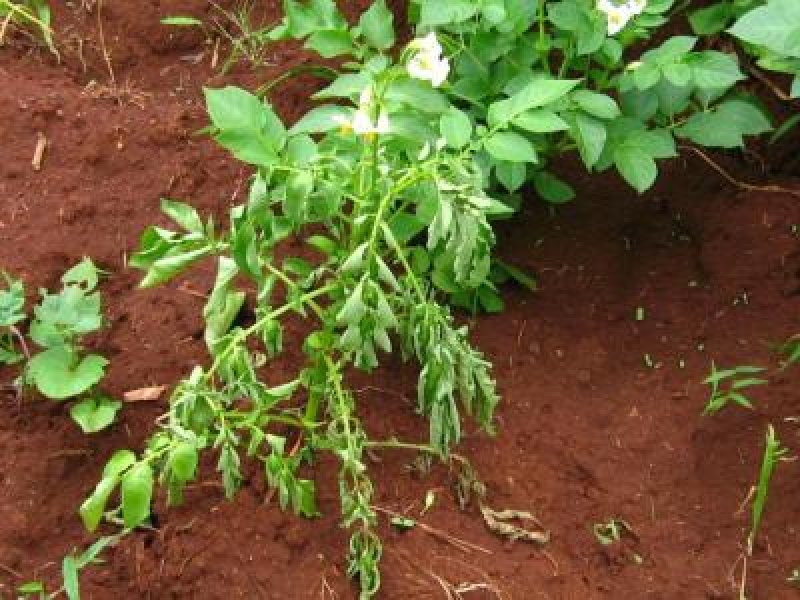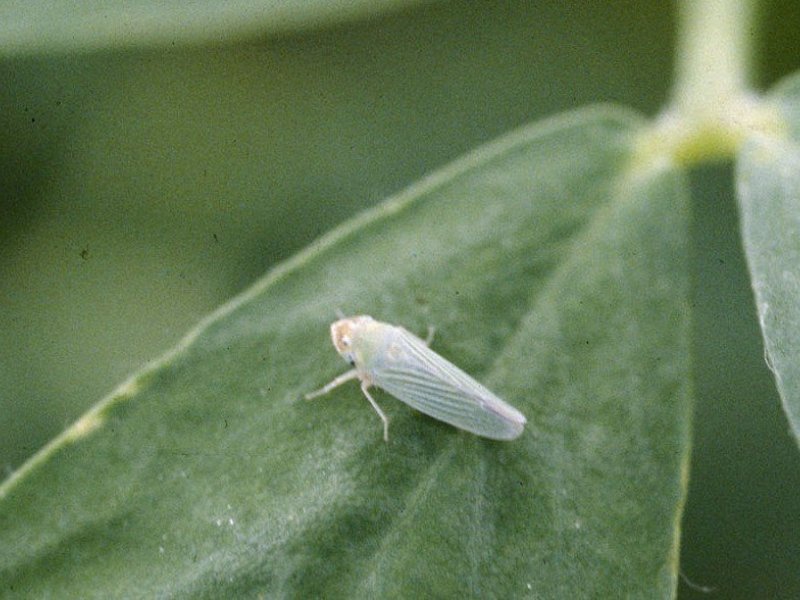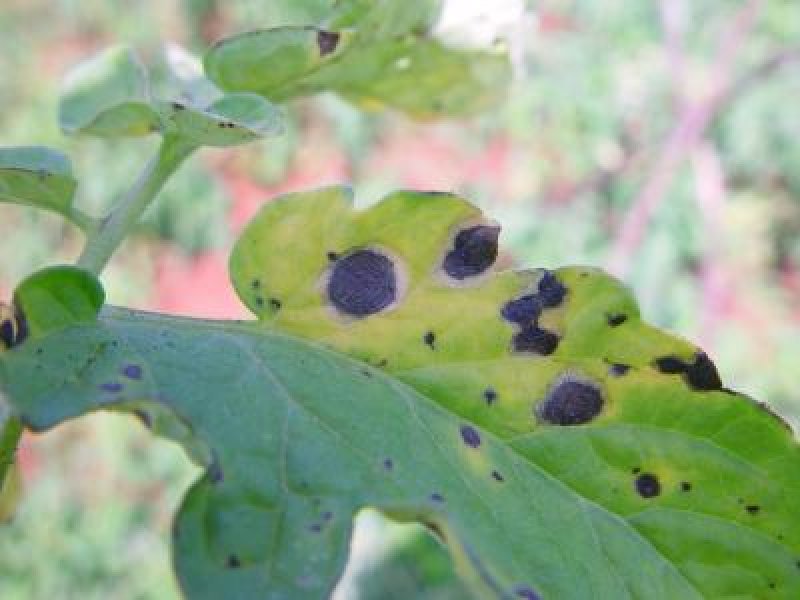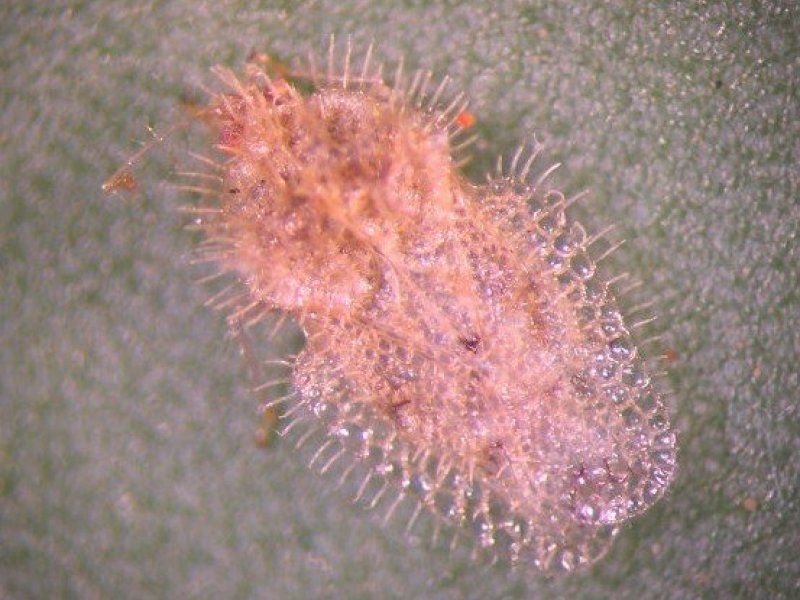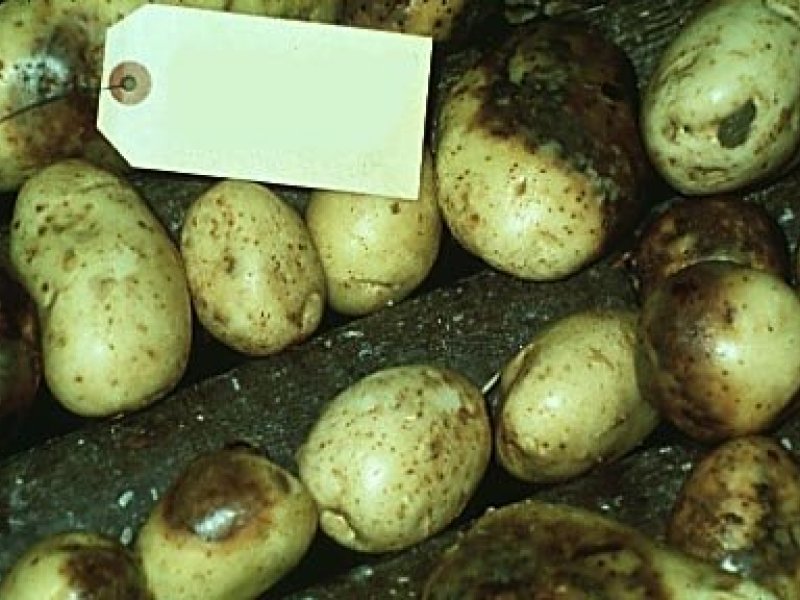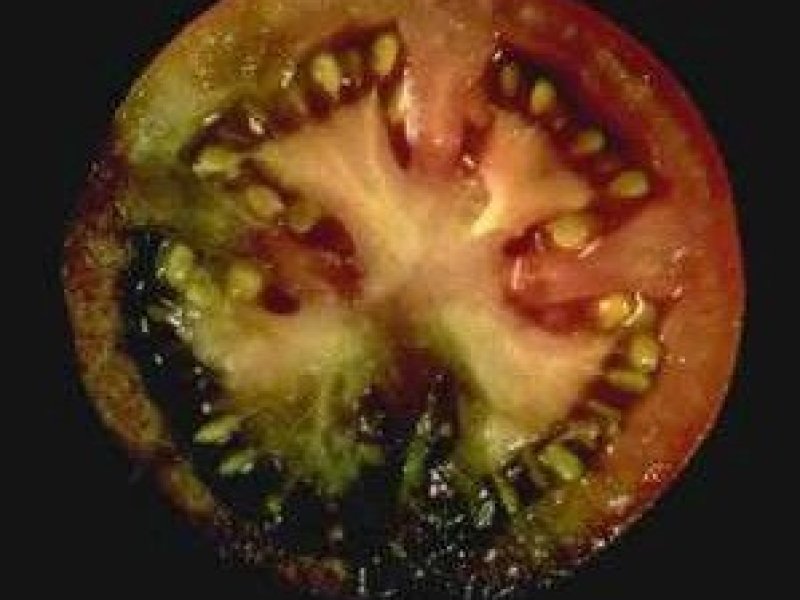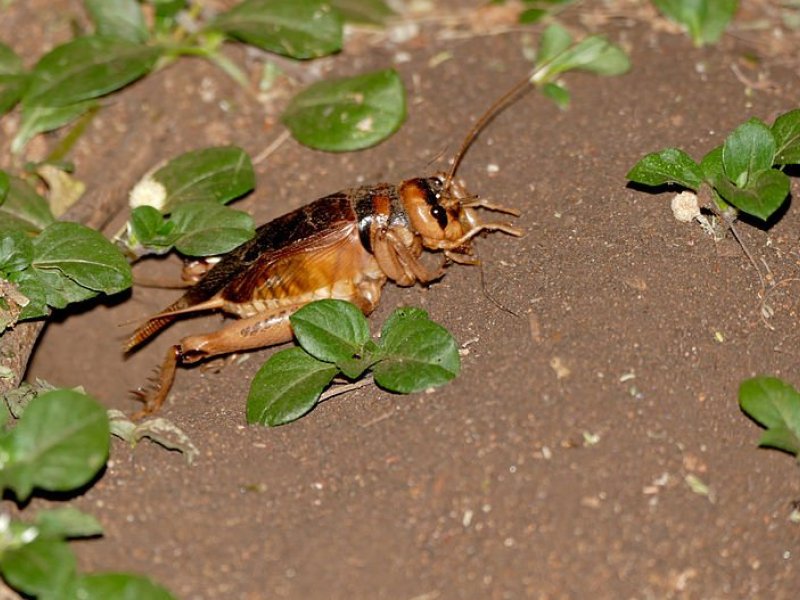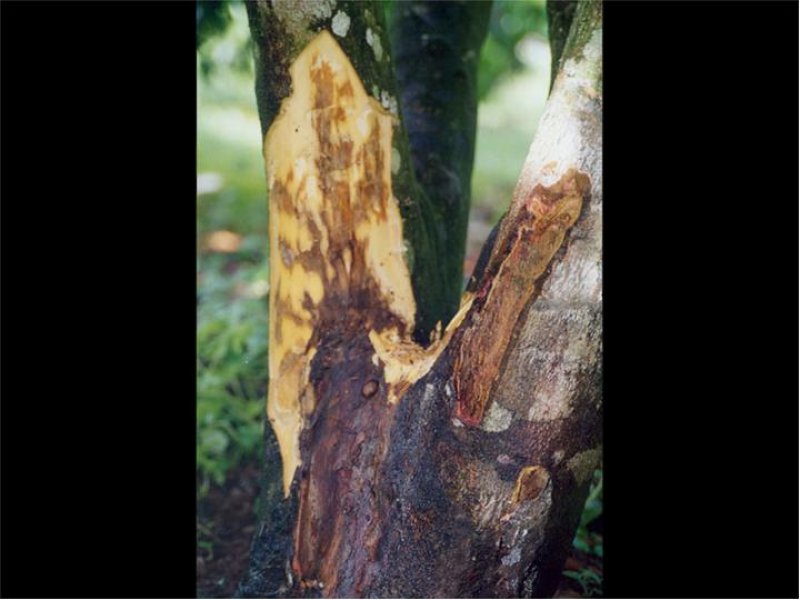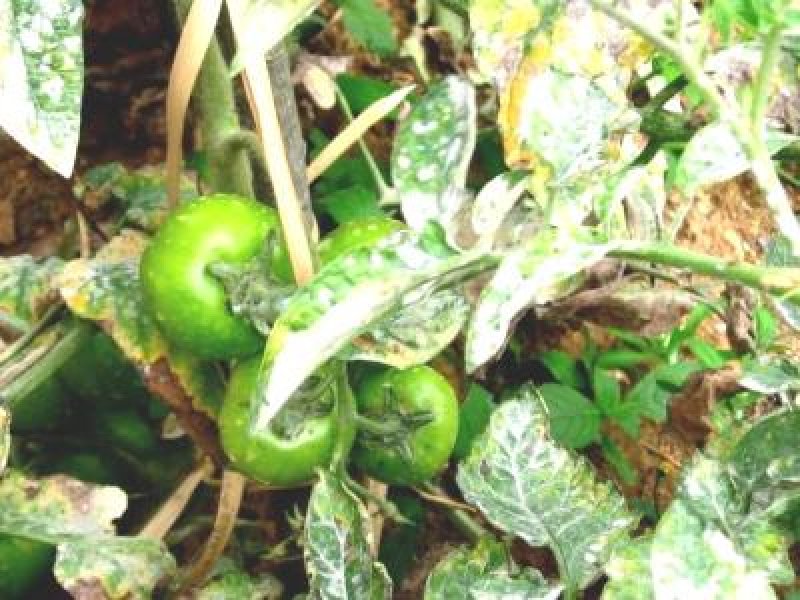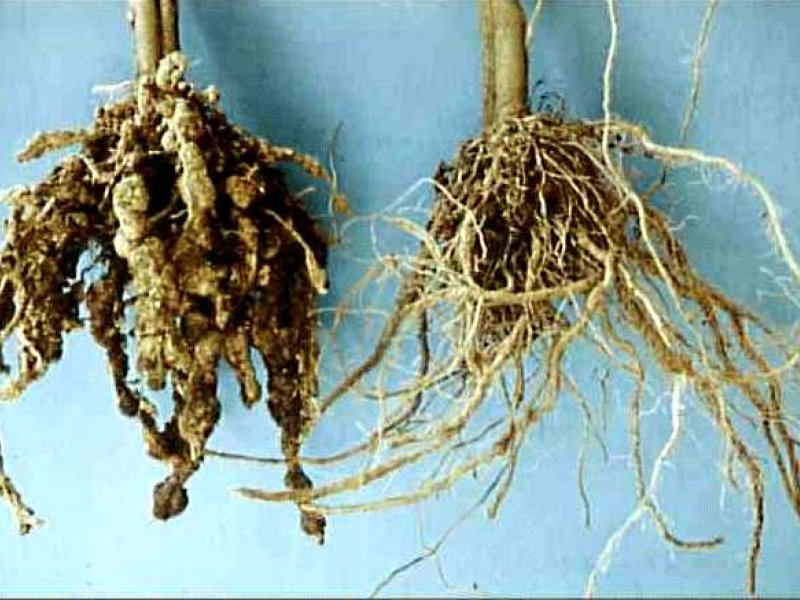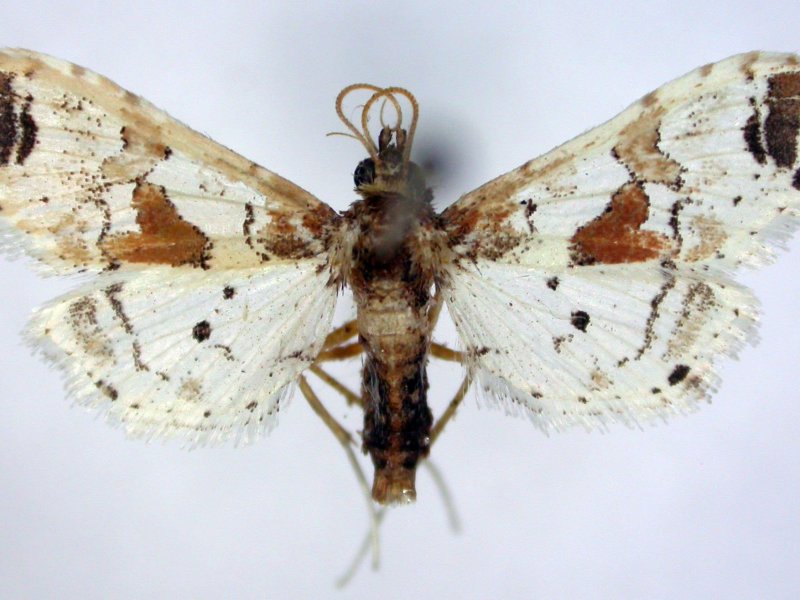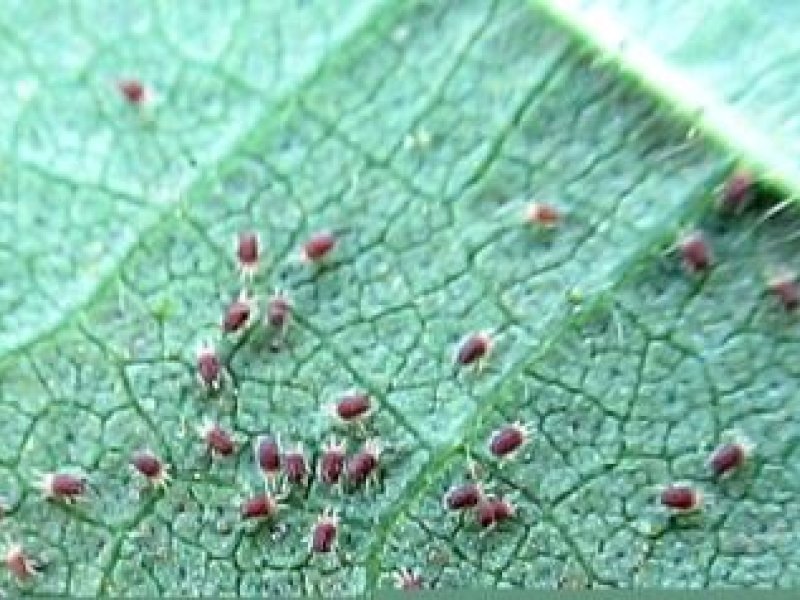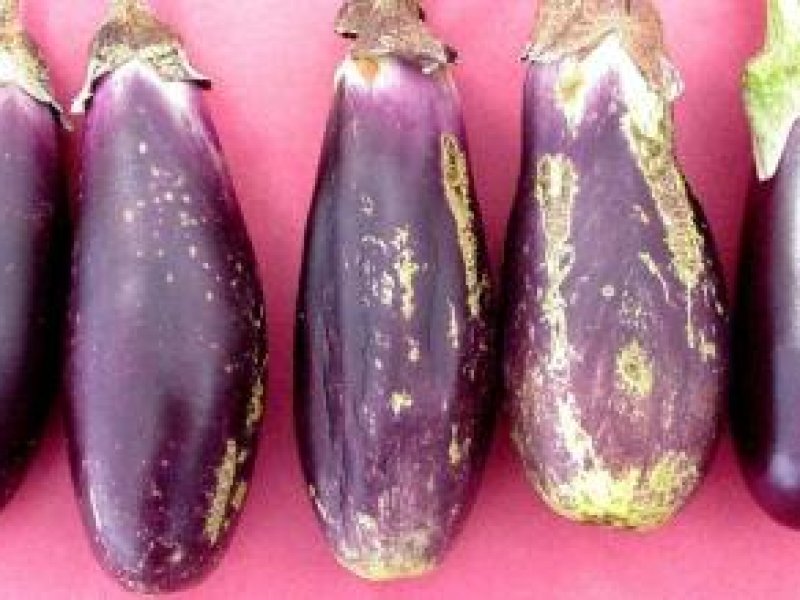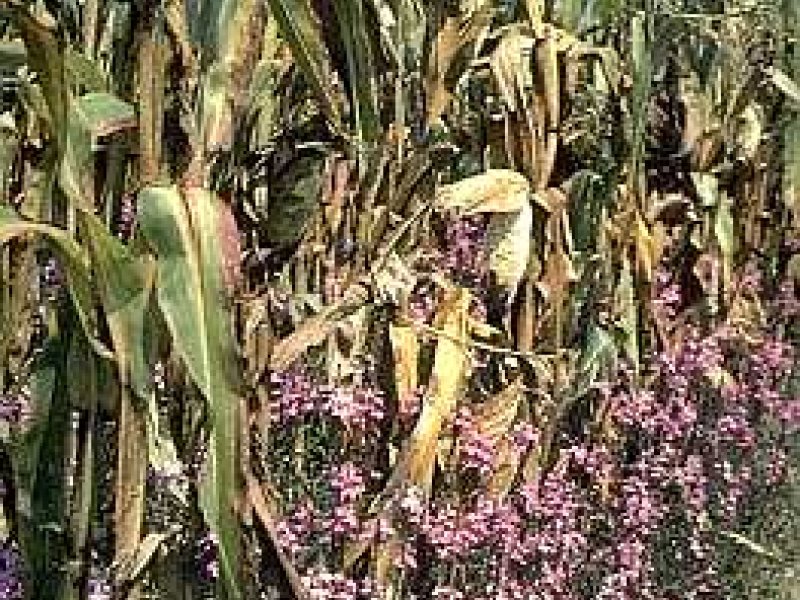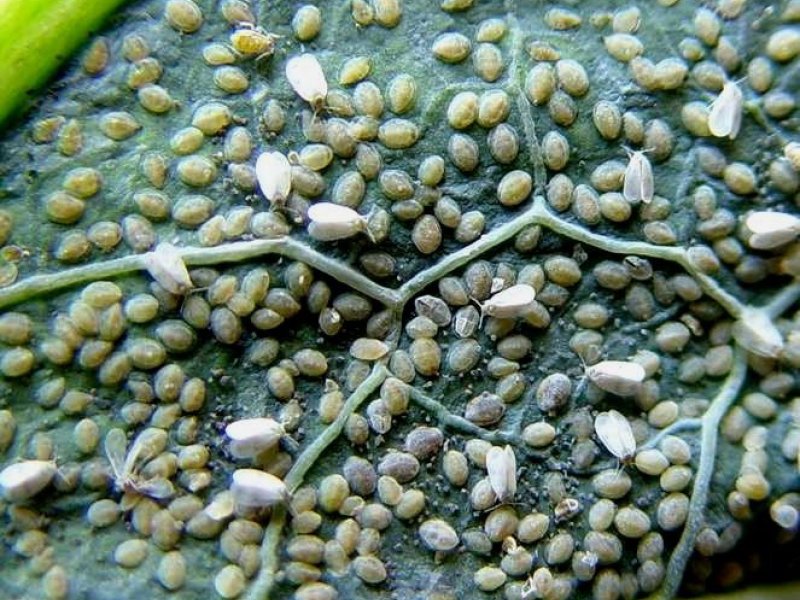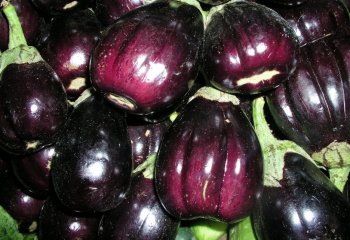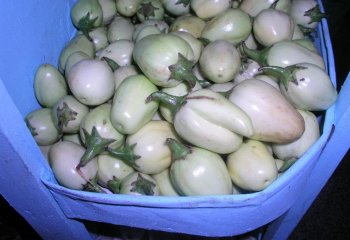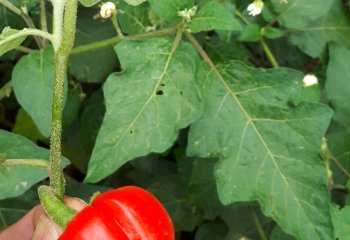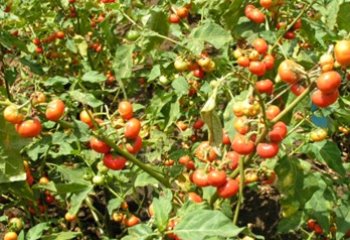|
Anthracnose (Colletotrichum melongenae) Spots of fruits are sunken. When weather is moist, the spots get tan-coloured (growth of fungal spores). There may be several spots on affected fruit and they may join up and cover the whole fruit. Severely affected fruits drop. Eventually, affected fruits dry and become black. Most often, soft-rot bacteria invade affected fruits and cause a soft watery decay. The fungus usually attacks fruits on plants that are weakened or over-ripe. Infection is favoured by relative humidity close to 100% and temperatures between 21 and 30°C. |
|
|
What to do:
|
|
Aphids (Aphis gossypii) Aphids are found in groups on the under surface of young leaves. When numbers increase they can move to upper leaf surfaces, stems and flowers. Aphids, in particular the cotton aphid, can become important pests in the cool dry season.
|
|
|
What to do:
|
|
Bacterial wilt (Ralstonia solanacearum) This disease occurs with bad drainage, especially in the hot, wet season and is often combined with symptoms of root-knot nematodes. Plants wilt and die suddenly. When newly infected stems are cut crosswise and placed in water, a greyish or yellowish ooze appears from the cut stem. The pathogen is soil-borne with a wide host range. Root-knot nematode infestation aggravates the disease development.
|
|
|
What to do:
|
|
Budworm (Scrobipalpa blapsigona) It is reported as one of the major pests of eggplants in Ghana. The small brown caterpillars of the budworm bore into flower buds and feed inside the flowers. This causes the flowers to drop off. Budworm damage is often overlooked, but it can be serious, leading to very low fruit set (Youdeowi, 2002).
|
|
|
What to do:
|
|
Cotton leafhoppers or jassids They are small insects (1-3 mm long), green in colour with slender tapered bodies. Leafhoppers are very mobile. The adults hop away when disturbed. Nymphs resemble adults, but have no wings, and run sideways when disturbed. The eggs are inserted in the leaf tissue on the underside of leaflets. They feed mainly on the underside of eggplant leaves, causing small yellow patches on leaves. Infested leaves curl upwards along the margin. Under heavy attack, leaves turn yellow and then brown and dry, giving a burned appearance. Fruit setting may be very low. Leafhoppers multiply rapidly during dry spells and can cause extensive damage.
|
|
|
What to do:
|
|
Cutworms (Agrotis spp.) These caterpillars are serious pests particularly in nurseries and of newly transplanted plants. They attack eggplants and many other plants at night. They cut seedlings and usually drag them down into the soil leaving the clean-cut stem. They cannot cut older plants. Large ground beetles, frogs, and birds prey cutworm.
|
|
|
What to do:
|
|
Early blight or Alternaria leaf and fruit spots (Alternaria spp.) Several Alternaria spp. are involved. These include A. melongenae, A. solani and A. tenuis. They cause leaf spotting and fruit rots. They produce leaf spots with concentric rings. The spots are mostly irregular, 4 to 8 mm in diameter and may enlarge and cover a large area of the leaf blade. Severely infected leaves drop off prematurely resulting in the reduction of yield. Fruit spots are circular, brown, dry and hard.
|
|
|
What to do:
|
|
Eggplant lace bug (Urentius hystricellus) It is a small bug (about 3 mm in length), brownish in colour. Its body is covered with spines and the wings show a distinct lace-like appearance. Nymphs resemble adults, but are initially wingless, developing wings as they grow. Both adults and nymphs are usually found in groups on the underside of leaves. They suck sap from the leaves causing whitish to yellowish mottled patches on the leaves. In case of serious infestations the leaves turn entirely yellow and drop off. Attacked leaves are speckled with small black shiny spots, which are the faeces of the bugs.
|
|
|
What to do:
|
|
Epilachna beetles (Epilachna spp.) The adult beetle is oval in shape, about 6 mm in length and reddish brown in colour with black spots on their backs. They look very similar to the beneficial ladybird beetles (predators), but the body of this pest ladybird beetle is covered with short, light coloured hairs, which give them a non-glossy or matt appearance. The larvae are pale yellow and covered with branched spines. They feed on the leaves of eggplants by scraping the surface and eating the leaf tissue between the veins. Attacked leaves may be completely stripped to the mid-veins to skeletons. They may also feed on fruits causing small shallow hollows on the fruit surface. High numbers of these beetles can cause considerable damage.
|
|
|
What to do:
|
|
Fusarium wilt (Fusarium oxysporum f.sp. melongenae) Affected plants show yellowing of leaves that progressively wilt and die from bottom upwards. Woody stem and root tissue of diseased plants turn brown. This fungus does not affect tomatoes. Optimum temperature for its growth on eggplants is 27.8 °C.
|
|
|
What to do:
|
|
Late blight (Phytophthora infestans) The late blight fungus affects tomatos, potatoes and eggplants but not pepper. Its symptoms consist of brown spots with purplish tinge and they can develop on leaves, stems, branches and both green and ripe fruits. In moist weather it can cause complete defoliation and rotting of fruits.
|
|
|
What to do:
|
|
Mole crickets, Tobacco Cricket (Brachytrupes spp.) Mole crickets are a local sporadic pest of many crops including tobacco, tomato, tea and cotton. They have been reported as major pests of eggplants in Ghana. seedlings are particularly vulnerable.
|
|
|
What to do:
|
|
Phytophthora fruit rot (Phytophthora parasitica) Phytophthora fruit rot fungus can cause damping-off in seedbeds, leaf spotting and collar rot on the main stem final resulting in plant death. The fungus may attack fruit at any growth stage and any part of the fruit. Spots on the fruit are dark brown, water-soaked and may have a light-coloured border. A whitish mould develops on the spots when wet conditions prevail. The spots are neither sunken nor exhibit concentric rings (zonation). Infected fruits drop prematurely.
The fungus is soil-borne. It is spread in the field by run-off water and farm implements. The disease is favoured by prolonged periods of high moisture and temperatures near 30° C.
|
|
|
What to do:
|
|
Powdery mildew (Leveillula taurica) Symptoms appear as yellowish spots on the leaves. On the lower surface of affected leaves the spots are covered by a whitish growth constituting spores of the fungus. Affected leaves eventually dry up but do not fall off. The fungus is endophytic (grows within the leaf contrary to other powdery mildew fungi that are grow on surface of the leaves). It has a wide host range. It is not seed-borne but it survives on herbaceous weeds and other susceptible hosts. Temperatures slightly above 20 degC, dry conditions and fairly high relative humidity favour disease infection. However, fungal dispersal takes place mainly at low humidity.
|
|
|
What to do:
|
|
Root-knot nematodes (Meloidogyne spp.) Eggplant is highly susceptible to root-knot nematodes, especially on sandy soils. Symptoms of infestation by root-knot nematodes are similar in all crops: wilting of plants and if infested plants are pulled from the soil the roots can be seen to be distorted, swollen and bearing knots. The infested roots eventually rot and affected plants die.
|
|
|
What to do:
|
|
Shoot and fruit borer (Leucinodes orbonalis) It is a major pest of eggplant. The adult is a small moth, with a wingspan of 18-24 mm, white in colour with a pink and bluish tinge, and a few brown spots on its wings. Moths lay creamy white single eggs on leaf undersides, stems, flower buds, or the base of fruits. Upon hatching the caterpillars (white in colour) bore into the top section of fruits and tender shoots. Caterpillars develop inside fruits and stems reaching a length of 15-18 mm. When fully-grown, caterpillars make a small hole in the fruit or shoot and drop to the soil and pupate among fallen debris.
When plants start bearing fruits, most caterpillars prefer to feed on the tender fruits. The damage to the shoots is not seen until they droop as a result of the caterpillar feeding inside them. Recently damaged fruits are not easy to detect. The first indication of damage to the fruit is a small hole just below the calyx where the insect has entered. Fruits are filled with frass. They change colour and taste; they drop off and are unmarketable. Caterpillars are difficult to control with pesticides. Within hours of hatching from eggs, caterpillars enter the shoots or fruits, and are not reached by contact pesticides.
|
|
|
What to do:
|
|
Spider mites (Tetranychus spp.) Spider mites may become serious pests of eggplant during the dry season. Attacked leaves show a stippled appearance (white specks), and their surface covered with a fine web. Continuous infestation causes the leaves to dry-up. The plants are stunted and yields reduced.
|
|
|
What to do:
|
|
Thrips (Thrips spp and Frankliniella spp.) Thrips are small (1.5 mm long), slender, brown insects with pale yellow hind wings that appear as a yellow line down the back of the body when the insect is at rest. Adult thrips have characteristic wings; the transparent wings have a fringe of hairs around the outside edge standing out in the same plane as the wing.
Thrips attack eggplant mostly during the dry season. They cause browning of leaves, especially on the lower leaf surface. In severe cases, the entire leaf dries. Thrips feeding on fruits causesscarring, irregular discolouration and deformation, which reduce the market value of fruits.
|
|
|
What to do:
|
|
Weeds Eggplant is slow to become established and cannot compete with aggressive weeds. Weeds also harbour insect pests and diseases. |
|
|
What to do:
|
|
Whiteflies (Bemisia tabaci) Whiteflies feed on leaves of eggplant sucking plant sap. Whiteflies are vectors of the mosaic virus reported to occasionally affect eggplant in West Africa.
|
|
|
What to do:
|
Geographical Distribution in Africa
Geographical Distribution of Eggplant in Africa. Updated on 8 July 2019. Source FAOSTAT
© OpenStreetMap contributors, © OpenMapTiles, GBIF.
Read more
Cameroon: Aubergine sauvage (local French); Zon (Ewondo) (Koné et al., 2019).
DRC: Mbolongu (Kongo) (S melongena) (Latham and Konda, 2006)
Ghana: Etruopue, Ntoropo (Koné et al., 2019)
Kenya: Mbiringanya, Mbilingani (Swahili) (S.melongena)
Malawi: Mabilingano (Yao) (S melongena) (Maundu, 2003)
Mozambique: Barinjera, Mabirinzara (S.melongena) (Maundu, 2003)
Nigeria: Igba ijesu(Yoruba); Ayanra, Afefea (Igbo); Yalo, Jauta(Hausa) (Aiyeloja A.A and O.A Bello, 2019)
South Africa: Eiervrug (Afrikaans) (Koné et al., 2019)
Tanzania: Ngogwe, Nyanyachungu (Koné et al., 2019)
Uganda: Enjagi (Rutooro) (Koné et al., 2019)
General Information and Agronomic Aspects
Introduction
Solanum melongena, commonly known as eggplant or aubergine, belongs to the family Solanaceae and the genus Solanum. The Solanum genus consists of more than 1000 species and is widely distributed, with approximately 100 native African species. The genus Solanum includes many economically important plants, including tomatoes, potatoes, and eggplants.
The exact origin of S. melongena is not entirely clear, but it is believed to be native to South Central China, Laos, Myanmar, Thailand, and Vietnam. Today, they are widely grown in many countries, especially in tropical and subtropical regions, where the climate is suitable for their growth..
Eggplants are widely utilized as a food source in many cuisines worldwide. Their versatile nature allows them to be prepared in various ways, including grilling, roasting, frying, and baking. They are used in a wide array of dishes, including curries, stews, salads, dips, and spreads. Eggplants are prized for their ability to absorb flavors from other ingredients, making them a popular addition to many cuisines around the world. The young and almost mature fruits are used as a vegetable. The fruit is a good source of vitamin A and C, potassium, phosphorous and calcium. They may be roasted, fried, stuffed, cooked as curry or pickled. Cooking for prolonged periods will destroy most of the vitamins. In Kenya production is done throughout the year and the bulk of the crop is exported. The fruits of the white varieties have medicinal value for diabetics. Eggplant has a cropping period of 4-7 months. In Kenya they are normally planted from beginning of June to end of December to correspond with the export season from October to May.
Eggplants are low in calories and fat but rich in dietary fiber, vitamins, and minerals. They are particularly abundant in antioxidants like anthocyanins, which give eggplants their characteristic purple color and have been associated with numerous health benefits. Beyond culinary uses, eggplants have also been utilized in traditional medicine in some cultures. They have been believed to have anti-inflammatory properties and have been used to treat various conditions, including digestive issues and skin problems.
(Daunay, M. & Chadha, M., 2004, Lester, R.N. & Seck, A., 2004, Bukenya-Ziraba, R., 2004, Kew botanical gardens, North Carolina Extension Gardener (n,d)).
Species account
Solanum melongena is an annual herb to perennial shrub growing to a height of 150-200 cm, often much branched with a long taproot which extends deep into the ground. Its stems and leaves are densely covered with star-shaped (stellate) hairs and sometimes prickles. Leaves: alternate, simple, with a petiole (appendage which connects the blade to the stem) 6-10 cm long. Flowers: are hermaphrodite, generally smooth and shiny with many seeds. Fruits: Globular to ovoid, ellipsoid in shape and available in purple, green, white, and variegated colors. The deep purple eggplant has very high gloss.
The fruit is consumed while still immature, displaying a glossy and vibrant appearance. However, once it reaches maturity, the flesh becomes bitter and fibrous, and the seeds harden. Certain cultivars are enjoyed raw.
(Plant village. (n.d), Daunay, M. & Chadha, M, 2004, Kew botanical gardens).
Ⓒ Food of the Nairobi people, 2005
Ⓒ Food of the Nairobi people, 2005
Varieties of S. melongena
Seeds of the below listed varieties are commercially available in all seed companies in Kenya. Information on seed companies in Kenya can be obtained from Horticultural Crops Development Authority (md@hcda.or.ke www.hcda.or.ke +2542088469)
• "Black Beauty" It takes about 100 days from transplanting to harvest. The fruit is oval to heart shaped glossy purple to almost black. Fruit size is about 10 x 8 cm. It has a good shelf life. It is unsuitable in cold wet areas.
• "Florida High Bush" From transplanting to harvest is about 100 days. Fruit shape is elongate oval. Fruit size is about 15 x 8 cm. It is unsuitable for cold wet areas.
• "Ravaya" It is an early maturing (about 80 days), high yielding variety. The fruits are slender, purple-coloured and borne in bunches of 3-4. This variety is popular for fresh export market.
• "Long Purple". It is ready for harvest about 70-80 days after transplanting. Fruit shape is cylindrical. Fruit size is about 11 x 5 cm. It is unsuitable for cold wet areas
• ."Early Long Purple". From transplanting to harvest is 90 days. Fruit shape is long cylindrical. Fruit size is about 12 x 6 cm. It is unsuitable to cold wet areas.
Related species
Solanum aethiopicum commonly known as African eggplant, is native to Africa, domesticated from the wild Solanum anguivi Lam., via the semi-domesticated Solanum distichum Schumach. & Thonn. Over time, it has spread beyond its native lands and can now be found in different countries across Asia, Europe, and the Americas.
Solanum aethiopicum is a perennial herbaceous plant typically growing to a height of 1 to 2 m. Leaves: alternate and can vary in shape, from ovate to lanceolate, sometimes featuring lobes. Flowers: star-shaped flowers displaying color variation, from elegant white to captivating purple. Fruits: edible fruits, show diversity in shapes, sizes, and colors, including green, yellow, red, and purple. They find their place as a delightful vegetable in numerous culinary creations, such as stews, soups, and stir-fries, offering a unique flavor and texture to dishes.
The leaves, too, have their use as leafy vegetables in cooking and contribute valuable nutrients to diets. In traditional medicine, different parts of the plant have been employed to address various health issues, such as skin infections, stomach ailments, and respiratory problems
Within Solanum aethiopicum, four cultivar-groups are recognized, three of which hold particular significance in Africa.
©Maundu 2021
• Gilo Group: The Gilo Group includes cultivars that are widely grown and valued for their large, round, and glossy fruits. Depending on the location, preferences vary for cultivars with pure white, creamy white, pale green, dark green, brown, or purple fruits, as well as striped fruits in two or more colors. These eggplants are highly versatile and used in various culinary dishes, providing a mild, pleasant taste. The Gilo Group is known for its adaptability to different environmental conditions, making it a popular choice among farmers and a preferred option for local markets and household consumption in Africa.
• Shum Group are mainly known for its smooth mature leaves with tiny glandular hairs and non-prickly nature. The fruit is subglobose, about 1 to 3 cm in diameter. Primarily, it is used as a leafy vegetable, but ripe fruits are occasionally consumed too. This group is most prevalent in Central Africa, particularly popular in Cameroon and Nigeria. However, its popularity is even higher in Uganda, where it is locally called 'nakati.' It thrives in warm, high-rainfall areas or when grown under irrigation.
• Kumba Group: mainly found in hot, semi-arid regions of the Sahel. Its mature leaves are smooth, except for tiny glandular hairs, and they are not prickly. The fruit is depressed globose, deeply furrowed, and often divided into many small vesicles, measuring 5-10(15) cm in width. Both the fruits and occasionally the leaves are consumed. Its importance for Africa is not as pronounced as the other three groups.
• Aculeatum Group: have thorny stems and leaves with stellate hairs when mature. Its fruit is subglobose and furrowed, measuring 3–8 cm in diameter. While it is not consumed as food, it is grown for ornamental purposes or used as rootstock for tomatoes or eggplants. The cultivar is not cultivated in Africa.
(Lester, R.N. & Seck, A., 2004, Schippers, R. R, 2000)
© Maundu P, 2015
Solanum anguivi is native to Africa, widely distributed on the African continent and its neighboring islands and Arabia. It has been recorded from West Africa, as well as Central Africa, East Africa, southern Africa and Madagascar, but it probably occurs in all non-arid regions throughout tropical Africa. It grows mostly in the wild, but sometimes, e.g. in Uganda and Côte d’Ivoire, it is a semi-cultivated vegetable.
S. anguivi is an upright woody herb or shrub, growing to a height of 4 m. Stems and leaves armed with straight or somewhat curved spines, yellowish to brownish, sometimes purple near the base, up to 13 mm long, branches often purple tinged. All parts covered in stellate hairs. Leaves: rhombic-ovate, elliptic or lanceolate, thinly stellate hairy above, densely so below. The central ray of the stellate hairs often much longer than the lateral rays. Leaf margin subentire to triangularly lobed. Prickles usually present on the midrib and main veins. Flowers; arranged in clusters of up to 20 blooms and have a pale mauve or purple color, with a star-like shape. Fruits: 6-12 mm in diameter, spherical, green, turning yellow and glossy orange-red when ripe. Edible when mature.
(Hyde, M.A., et al.,2023, Bukenya-Ziraba, R., 2004).
Ecological information
Optimum day temperatures for eggplant are in the range of 25-35degC and night temperatures from 20-27degC. Eggplant is more susceptible to low temperatures than tomato and capsicum and it does not tolerate frost. It is tolerant to drought and excessive rainfall, but struggles to grow when temperatures exceed 30degC, and where water logging occurs. When temperature and humidity are high, eggplant becomes more vegetative. Eggplant does best in well-drained, sandy loam soils. The best environmental conditions are normally found in lowland areas with relatively little temperature variation. When grown at altitudes above 800 m, growth is retarded and yields reduced. The pH requirements range from 6 to 7 with the optimum being pH 6.4.
Agronomic Aspects
a. Planting materials
Eggplant is commonly propagated through seeds, but it can also be propagated by rooting healthy shoots. African eggplant seeds can be obtained from seed companies or directly from farmers. It is advisable for farmers to produce their own seeds to ensure self-sufficiency. When cultivating plants for seed production, it is best to isolate them from other solanaceous plants such as tomatoes and potatoes, preferably on soils that have not recently grown these crops. For optimal seed production, a wider seed spacing of 60 cm x 20 cm is recommended, resulting in a seed rate of 1.5 kg seed/ha
Soaking the seeds in water for 24 hours speeds up germination. No treatment is needed when sowing fresh, vigorous seed in sterilized soil. Otherwise, soak seeds in warm water (50 degC) for 30 minutes, rinse them in cold water, and dry them before sowing. For information on hot-water treatment for seeds click here (Kalb et al., 2002).
b. Planting
Disease-free seeds may be sown directly or started in a nursery. The vegetable can be grown as a pure stand or intercropped with other food crops. They can be grown alone or as intercrops with other food crops. To ensure optimal growth, it is important to properly prepare the land. This involves digging to loosen the soil and remove any hardpan. In drylands, terracing is recommended to retain rainwater within the farm. After digging, well-decomposed manure is incorporated into the soil to create a well-drained structure with fine particles.
The prepared land is then divided into beds, preferably one meter wide. In wet and humid areas, raised beds are suitable, while sunken beds work well in dry areas or seasons. Additionally, farmyard manure or compost is applied and thoroughly mixed. To sterilize the soil, prevent soil-borne diseases, and control weeds, a layer of grass or similar material can be burned on top of the bed. This also adds a nutrient-rich ash, especially potash, to the soil. (Kalb et al., 2002).
Nursery Bed management
African eggplants thrive when initially grown in a nursery bed and later transplanted to the main garden. To create the nursery bed, select a location away from drainage channels or slopes, yet accessible to a water source. Use friable soil (soil that breaks or crumbles easily when handled). In humid areas, raise the nursery bed at least 20cm above the ground to prevent waterlogging, while in arid and semi-arid regions, make it sunken to reduce water loss, shaded seedbed is recommended. Before sowing an application of 3 to 5 kg of good compost per m2 is incorporated into the nursery seedbed.
Seeds can be sown by broadcasting or in rows (row planting). Mix the seeds with fine soil at a ratio of about 1:10 (seed to soil). If broadcasting, combine the seeds with dried poultry manure, ash, fine soil, or sand at a ratio of 1:10 to 1:20. Create 2cm deep furrows spaced 15cm apart. Sow the seeds and lightly cover them with soil. Apply mulch and water through it, preferably in the evening. The seedlings emerge after 8-10 days. Before planting, fertilize the field with compost or farmyard manure.. Remove the mulch from the seedlings and place it between the rows. Provide shade over the nursery using light materials that allow sunlight to reach the seedlings.
Transplant the seedlings after 1-1.5 months of germination. The ideal transplant is a seedling with three to four true leaves, stocky and disease-free, and without flower buds. Begin hardening plants 6 to 9 days before transplanting to reduce transplanting shock. Slightly withhold water. Thoroughly water seedlings 12 to 14 hours before transplanting to the field. Transplanting should be done in the late afternoon or on a cloudy day in order to minimise transplanting shock. Space the plants 1m apart between rows and individual plants. Prior to transplanting, add two handfuls of well-decomposed manure per planting hole (Kalb et al., 2002). Transplant seedlings by digging a hole deep enough to bury a plant so that its first true leaf is just above the soil surface. Press the soil firmly around the root. Irrigate furrows immediately after transplanting.
Watering newly transplanted plants well with compost tea or EM (effective microorganisms) will give the seedlings a good start. To prepare your own compost tea, mix 1 part of compost with 6 parts of water. Leave the mixture for one week. Strain and spray on seedlings to control fungal pathogens and prevent infection.
Transplanting and spacing
The ideal transplant is a seedling with three to four true leaves, stocky and disease-free, and without flower buds. Begin hardening plants 6 to 9 days before transplanting to reduce transplanting shock. Slightly withhold water. Thoroughly water seedlings 12 to 14 hours before transplanting to the field. Transplanting should be done in the late afternoon or on a cloudy day in order to minimize transplanting shock. Before transplanting, place a basal dose of 15 to 30 tons/ha compost or well-rotted farmyard manure in the planting furrows or planting holes and mixed with the soil.
Transplant seedlings by digging a hole deep enough to bury a plant so that its first true leaf is just above the soil surface. Press the soil firmly around the root. Irrigate furrows immediately after transplanting.
Watering newly transplanted plants well with compost tea or EM (effective microorganisms) will give the seedlings a good start. To prepare your own compost tea, mix 1 part of compost with 6 parts of water. Leave the mixture for one week. Strain and spray on seedlings to control fungal pathogens and prevent infection (Kalb, T et al, 2002).
Direct sowing
Direct sowing either in irrigation systems or rain-fed results in taller plants and when there is adequate room, in more and larger leaves and branches and better dry-matter content when compared with transplanting. The seeds are planted by broadcast or in lines. If by broadcast, one should ensure even distribution. A seed rate of 1.5kg/ha is used (Kalb et al., 2002).
Thinning
After germination, the strongest plants are retained, and the others removed for transplanting or consumption. Thinning should be done with the type of nightshade and hence its growth habit and size in mind. Four weeks after planting, the crop is thinned (starting with taller ones) to leave a spacing of about 15 cm from one plant to the other during the dry season. Thinning can be continued on regular basis until the desired spacing is reached, which depends a lot on the species. During thinning, the whole plant is uprooted. Thinned plants should be brought to the marketplace with their roots attached and moistened to retain their fresh appearance.
Crop rotation
Eggplants should not be planted after tomato, pepper, potato, or other solanaceous crops to prevent a recurrence of the same pests and disease pathogens. Rotate eggplants with other crops like onions, cereals or legumes. Planting eggplant after rice reduces the incidence of bacterial wilt and nematodes.
Husbandry
Side dressing with groundnut cake is recommended 40 days after transplanting. Also at this period, remove three nodes at the tips of the plants to improve branching and to increase the number of fruits. Weed control should be shallow, to avoid damage to the roots. Tall-growing cultivars will also require support. Supplementary irrigation is required during dry periods. Mulching with dried plant materials reduces moisture loss and weed problems. Apply well-decomposed farm yard manure and neem cake as basal fertilizers.
Harvest, post-harvest practices and markets
Harvest
The first harvestable fruits appear 60-90 days after planting, when the skin becomes glossy, smooth, and fully colored. Harvest fruits when they are about two-thirds of their maximum size. Harvesting is done once or twice a week by cutting the fruit from the stem and leaving a short piece of stem on the fruit. For seed production, harvest only fully mature fruits from healthy and productive plants. Yields of 20 to 25 tons/ha of immature fruits can be expected.
Post-harvest practices.
After harvesting, sort the eggplants, remove any damaged, overripe, or diseased fruits. Gently clean the eggplants by wiping off dirt and debris using a soft cloth or brush. Eggplant fruits are prone to rapid dehydration after being harvested, causing them to lose their color, brightness, and smoothness. It is advisable to sell the fruits within a few days after harvesting. To preserve freshness, store the harvested eggplants in a cool and well-ventilated area. When packaging, make sure to use ventilated containers to prevent moisture buildup and decay. If stored under controlled conditions, the fruits can be kept for up to 10 days, but it's essential to maintain a storage temperature above 15°C to avoid cold injury.
(Daunay, M.-C. & Chadha, M.L., 2004, Kalb et al., 2002)
Value chain and Markets
Eggplant has a strong presence in the global market, and its popularity has been steadily increasing due to its versatility in various cuisines and its nutritional benefits. As a result, the demand for eggplant and its processed derivatives has been growing steadily in recent years. Major producers include China, India, Egypt, Turkey, and Iran. China accounts for more than 60 % of world's eggplant. These countries benefit from favorable climatic conditions and have well-established agricultural practices to support large-scale eggplant cultivation and production.
Africa contributes less than 4% to the global production and cultivation area of eggplant, with the majority, over 90%, coming from northern African countries. However, comprehensive data on eggplant cultivation in tropical Africa remains incomplete, and it may encompass various types of African eggplants, such as S. aethiopicum and S. macrocarpon. Local markets and street vendors play a significant role in selling eggplants to the general population, making them easily accessible to consumers. Additionally, supermarkets and grocery stores in urban areas also stock eggplants, making them available to a broader consumer base. With the increasing urbanization and changing dietary preferences in Africa, the demand for eggplants is expected to rise, presenting opportunities for further value addition in the form of processed eggplant products (Daunay, M.-C. & Chadha, M.L., 2004, Tridge.com).
Fresh Quality Specifications for the Market in Kenya
The following specifications constitute raw material purchasing requirements.
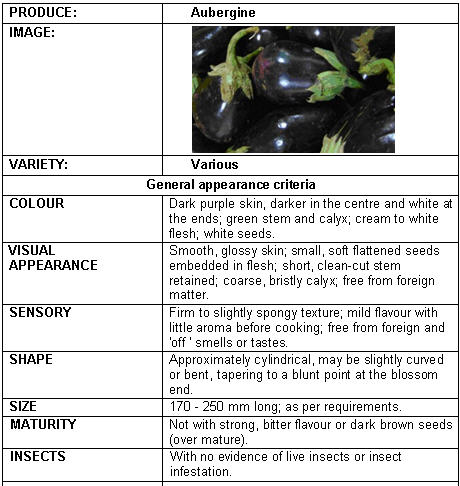
© S. Kahumbu, Kenya
Nutritional value
Eggplant is a versatile vegetable that can be prepared by baking, roasting, grilling, or sautéing, and relish.
The fruit vegetable is low in calories, making it an excellent choice for individuals aiming to maintain or lose weight. Eggplant is a great source of dietary fiber, which aids in digestion and promotes a healthy gut. Fiber helps regulate bowel movements, prevents constipation, and may even reduce the risk of colon cancer.
Except for vitamin A, eggplants are low in most nutrients. Eggplants are however rich in antioxidants, specifically nasunin, chlorogenic acid, and anthocyanins. These powerful compounds help protect the body's cells from damage caused by oxidative stress, reducing the risk of chronic diseases like heart disease and certain types of cancer.
Moreover, eggplant is a low-glycemic food, meaning it has a minimal impact on blood sugar levels. This quality makes it an ideal choice for individuals with diabetes or those aiming to manage their blood sugar levels. Including eggplant in your diet may also provide anti-inflammatory benefits. Studies have shown that certain compounds found in eggplant can help reduce inflammation in the body, potentially alleviating symptoms associated with conditions like arthritis. To maximize the nutritional benefits, it's recommended to consume eggplant with its skin intact, as it contains a significant portion of the vegetable's antioxidants and fiber.
(Naeem & Ugur, 2019, KFCT, 2018, healthline.com, medicalnewstoday.com).
Table 1: Approximate nutritional composition of 100 g of eggplant
Eggplant / Brinjal, different varieties, whole edible, raw |
Eggplant / Brinjal, different varieties, whole edible, boiled, drained (without salt) |
Eggplant / Brinjal, different varieties, whole edible, stewed (without salt) |
Recommended daily allowance (approx.) for adultsa |
|
Edible conversion factor |
0.91 |
1 |
1 |
|
Energy (kJ) |
111 |
119 |
139 |
9623 |
Energy (kcal) |
27 |
29 |
33 |
2300 |
Water (g) |
90.8 |
90.1 |
88.5 |
2000-3000c |
Protein (g) |
1.2 |
1.3 |
1.5 |
50 |
Fat (g) |
0.3 |
0.3 |
0.4 |
<30(male), <20 (female)b |
Carbohydrate available (g) |
2.8 |
3 |
3.4 |
225 -325g |
Fibre (g) |
4 |
4.3 |
5 |
30d |
Ash (g) |
0.9 |
1 |
1.2 |
|
Mineral composition |
|
|
|
|
Ca (mg) |
18 |
19 |
23 |
800 |
Fe (mg) |
0.4 |
0.3 |
0.5 |
14 |
Mg (mg) |
21 |
14 |
26 |
300 |
P (mg) |
35 |
34 |
44 |
800 |
K (mg) |
200 |
108 |
250 |
4,700f |
Na (mg) |
3 |
2 |
4 |
<2300e |
Zn (mg) |
0.21 |
0.17 |
0.26 |
15 |
Se (mcg) |
1 |
0 |
1 |
60 |
Bioactive compound composition |
|
|
|
|
Vit A RAE (mcg) |
12 |
12 |
14 |
800 |
Vit A RE (mcg) |
24 |
24 |
27 |
800 |
b-carotene equivalent (mcg) |
146 |
141 |
164 |
600 – 1500g |
Thiamin (mg) |
0.05 |
0.03 |
0.06 |
1.4 |
Riboflavin (mg) |
0.05 |
0.03 |
0.06 |
1.6 |
Niacin (mg) |
1 |
0.4 |
0.6 |
18 |
Dietary Folate Eq. (mcg) |
29 |
16 |
25 |
400f |
Food folate (mcg) |
29 |
16 |
25 |
400f |
Vit C (mg) |
2 |
1 |
2 |
60 |
Source (Nutrient data): FAO/Government of Kenya. 2018. Kenya Food Composition Tables. Nairobi, 254 pp. http://www.fao.org/3/I9120EN/i9120en.pdf
RE=retinol equivalents.
RAE =Retinol activity equivalents. A RAE is defined as 1μg all-trans-retinol, 12μg beta-carotene, or 24μg α-carotene or β-cryptoxanthin.
a Lewis, J. 2019. Codex nutrient reference values. Rome. FAO and WHO
b NHS (refers to saturated fat)
c https://www.hsph.harvard.edu/nutritionsource/water/
d British Heart Foundation
e FDA
f NIH
g Mayo Clinic
| These caterpillars are serious pests particularly in nurseries and of newly transplanted plants. They attack eggplants and many other plants at night. They cut seedlings and usually drag them down into the soil leaving the clean-cut stem. They cannot cut older plants. Large ground beetles, frogs, and birds prey cutworm.
What to do:
|
| Budworm (Scrobipalpa blapsigona) It is reported as one of the major pests of eggplants in Ghana. The small brown caterpillars of the budworm bore into flower buds and feed inside the flowers. This causes the flowers to drop off. Budworm damage is often overlooked, but it can be serious, leading to very low fruit set (Youdeowi, 2002).
What to do:
|
| Whiteflies feed on leaves of eggplant sucking plant sap. Whiteflies are vectors of the mosaic virus reported to occasionally affect eggplant in West Africa.
What to do:
|
| Root-knot nematodes (Meloidogyne spp.) Eggplant is highly susceptible to root-knot nematodes, especially on sandy soils. Symptoms of infestation by root-knot nematodes are similar in all crops: wilting of plants and if infested plants are pulled from the soil the roots can be seen to be distorted, swollen and bearing knots. The infested roots eventually rot and affected plants die.
What to do:
|
| Eggplant is slow to become established and cannot compete with aggressive weeds. Weeds also harbour insect pests and diseases. What to do:
|
| Mole crickets, Tobacco Cricket (Brachytrupes spp.) Mole crickets are a local sporadic pest of many crops including tobacco, tomato, tea and cotton. They have been reported as major pests of eggplants in Ghana. seedlings are particularly vulnerable.
What to do:
|
| Thrips (Thrips spp and Frankliniella spp.) Thrips are small (1.5 mm long), slender, brown insects with pale yellow hind wings that appear as a yellow line down the back of the body when the insect is at rest. Adult thrips have characteristic wings; the transparent wings have a fringe of hairs around the outside edge standing out in the same plane as the wing.
Thrips attack eggplant mostly during the dry season. They cause browning of leaves, especially on the lower leaf surface. In severe cases, the entire leaf dries. Thrips feeding on fruits causesscarring, irregular discolouration and deformation, which reduce the market value of fruits.
What to do:
|
| They are small insects (1-3 mm long), green in colour with slender tapered bodies. Leafhoppers are very mobile. The adults hop away when disturbed. Nymphs resemble adults, but have no wings, and run sideways when disturbed. The eggs are inserted in the leaf tissue on the underside of leaflets. They feed mainly on the underside of eggplant leaves, causing small yellow patches on leaves. Infested leaves curl upwards along the margin. Under heavy attack, leaves turn yellow and then brown and dry, giving a burned appearance. Fruit setting may be very low. Leafhoppers multiply rapidly during dry spells and can cause extensive damage.
What to do:
|
| Aphids are found in groups on the under surface of young leaves. When numbers increase they can move to upper leaf surfaces, stems and flowers. Aphids, in particular the cotton aphid, can become important pests in the cool dry season.
What to do:
|
| Spider mites (Tetranychus spp.) Spider mites may become serious pests of eggplant during the dry season. Attacked leaves show a stippled appearance (white specks), and their surface covered with a fine web. Continuous infestation causes the leaves to dry-up. The plants are stunted and yields reduced.
What to do:
|
| Epilachna beetles (Epilachna spp.) The adult beetle is oval in shape, about 6 mm in length and reddish brown in colour with black spots on their backs. They look very similar to the beneficial ladybird beetles (predators), but the body of this pest ladybird beetle is covered with short, light coloured hairs, which give them a non-glossy or matt appearance. The larvae are pale yellow and covered with branched spines. They feed on the leaves of eggplants by scraping the surface and eating the leaf tissue between the veins. Attacked leaves may be completely stripped to the mid-veins to skeletons. They may also feed on fruits causing small shallow hollows on the fruit surface. High numbers of these beetles can cause considerable damage.
What to do:
|
| Eggplant lace bug (Urentius hystricellus) It is a small bug (about 3 mm in length), brownish in colour. Its body is covered with spines and the wings show a distinct lace-like appearance. Nymphs resemble adults, but are initially wingless, developing wings as they grow. Both adults and nymphs are usually found in groups on the underside of leaves. They suck sap from the leaves causing whitish to yellowish mottled patches on the leaves. In case of serious infestations the leaves turn entirely yellow and drop off. Attacked leaves are speckled with small black shiny spots, which are the faeces of the bugs.
What to do:
|
| Shoot and fruit borer (Leucinodes orbonalis) It is a major pest of eggplant. The adult is a small moth, with a wingspan of 18-24 mm, white in colour with a pink and bluish tinge, and a few brown spots on its wings. Moths lay creamy white single eggs on leaf undersides, stems, flower buds, or the base of fruits. Upon hatching the caterpillars (white in colour) bore into the top section of fruits and tender shoots. Caterpillars develop inside fruits and stems reaching a length of 15-18 mm. When fully-grown, caterpillars make a small hole in the fruit or shoot and drop to the soil and pupate among fallen debris.
When plants start bearing fruits, most caterpillars prefer to feed on the tender fruits. The damage to the shoots is not seen until they droop as a result of the caterpillar feeding inside them. Recently damaged fruits are not easy to detect. The first indication of damage to the fruit is a small hole just below the calyx where the insect has entered. Fruits are filled with frass. They change colour and taste; they drop off and are unmarketable. Caterpillars are difficult to control with pesticides. Within hours of hatching from eggs, caterpillars enter the shoots or fruits, and are not reached by contact pesticides.
What to do:
|
| Bacterial wilt (Ralstonia solanacearum) This disease occurs with bad drainage, especially in the hot, wet season and is often combined with symptoms of root-knot nematodes. Plants wilt and die suddenly. When newly infected stems are cut crosswise and placed in water, a greyish or yellowish ooze appears from the cut stem. The pathogen is soil-borne with a wide host range. Root-knot nematode infestation aggravates the disease development.
What to do:
|
| Powdery mildew (Leveillula taurica) Symptoms appear as yellowish spots on the leaves. On the lower surface of affected leaves the spots are covered by a whitish growth constituting spores of the fungus. Affected leaves eventually dry up but do not fall off. The fungus is endophytic (grows within the leaf contrary to other powdery mildew fungi that are grow on surface of the leaves). It has a wide host range. It is not seed-borne but it survives on herbaceous weeds and other susceptible hosts. Temperatures slightly above 20 degC, dry conditions and fairly high relative humidity favour disease infection. However, fungal dispersal takes place mainly at low humidity.
What to do:
|
| Anthracnose (Colletotrichum melongenae) Spots of fruits are sunken. When weather is moist, the spots get tan-coloured (growth of fungal spores). There may be several spots on affected fruit and they may join up and cover the whole fruit. Severely affected fruits drop. Eventually, affected fruits dry and become black. Most often, soft-rot bacteria invade affected fruits and cause a soft watery decay. The fungus usually attacks fruits on plants that are weakened or over-ripe. Infection is favoured by relative humidity close to 100% and temperatures between 21 and 30°C. What to do:
|
| Phytophthora fruit rot (Phytophthora parasitica) Phytophthora fruit rot fungus can cause damping-off in seedbeds, leaf spotting and collar rot on the main stem final resulting in plant death. The fungus may attack fruit at any growth stage and any part of the fruit. Spots on the fruit are dark brown, water-soaked and may have a light-coloured border. A whitish mould develops on the spots when wet conditions prevail. The spots are neither sunken nor exhibit concentric rings (zonation). Infected fruits drop prematurely.
The fungus is soil-borne. It is spread in the field by run-off water and farm implements. The disease is favoured by prolonged periods of high moisture and temperatures near 30° C.
What to do:
|
| Late blight (Phytophthora infestans) The late blight fungus affects tomatos, potatoes and eggplants but not pepper. Its symptoms consist of brown spots with purplish tinge and they can develop on leaves, stems, branches and both green and ripe fruits. In moist weather it can cause complete defoliation and rotting of fruits.
What to do:
|
| Fusarium wilt (Fusarium oxysporum f.sp. melongenae) Affected plants show yellowing of leaves that progressively wilt and die from bottom upwards. Woody stem and root tissue of diseased plants turn brown. This fungus does not affect tomatoes. Optimum temperature for its growth on eggplants is 27.8 °C.
What to do:
|
| Early blight or Alternaria leaf and fruit spots (Alternaria spp.) Several Alternaria spp. are involved. These include A. melongenae, A. solani and A. tenuis. They cause leaf spotting and fruit rots. They produce leaf spots with concentric rings. The spots are mostly irregular, 4 to 8 mm in diameter and may enlarge and cover a large area of the leaf blade. Severely infected leaves drop off prematurely resulting in the reduction of yield. Fruit spots are circular, brown, dry and hard.
What to do:
|
References and information links
References
1. Achigan‐Dako, E.G., Pasquini M.W., Assogba‐Komlan F., N’danikou S., Yédomonhan H., Dansi A., Ambrose‐Oji B. 2010. Traditional vegetables in Benin. Institut National des Recherches Agricoles du Bénin. Imprimeries du CENAP, Cotonou.
2. African Museums. Solanum melongena. https://www.africamuseum.be/en/research/collections_libraries/biology/prelude/view_plant?pi=911697
3. AIC, Nairobi, Kenya (2000). Local and Export Vegetables Growing Manual.
4. Aiyeloja A.A and O.A Bello (2019). Nigerian Herbs And Their Uses | Complete List Of Nigerian Herbs. https://www.spycroc.com/2019/03/nigerian-herbs-and-their-uses-complete.html
5. AVRDC, the World Vegetable Center (2003). Harmful and helpful insects in eggplant fields. www.avrdc.org
6. AVRDC, the World Vegetable Center. (2003). How to control eggplant fruit and shoot borer. www.avrdc.org
7. Beije, C.M., Kanyangia, S.T., Muriuki, S.J.N.,Otieno, E.A., Seif, A.A., Whittle, A.M.(1984). Horticultural Crops Protection Handbook. National Horticultural Research Station, Thika KEN/75/028 and KEN/80/017
8. Bohlen, E. (1973). Crop pests in Tanzania and their control. Federal Agency for Economic Cooperation (bfe). Verlag Paul Parey. ISBN: 3-489-64826-9
9. CAB International (2005). Crop Protection Compendium, 2005 Edition. Wallingford, UK www.cabi.org
10. Chen, Training Guide: Suggested Cultural Practices for Eggplant. www.avrdc.org. https://africasoilhealth.cabi.org/wpcms/wp-content/uploads/2017/03/
11. Critchley, B. R. (1995). Manual for the Integrated Pest Management of diseases, insects, nematodes and weeds of garden egg, okra, onion, peppers, and tomato in Brong Ahafo, Ghana. Natural Resources Institute (NRI). UK
12. Daunay, M.-C. & Chadha, M.L., 2004. Solanum melongena L. [Internet] Record from PROTA4U. Grubben, G.J.H. & Denton, O.A. (Editors). PROTA (Plant Resources of Tropical Africa / Ressources végétales de l’Afrique tropicale), Wageningen, Netherlands. <http://www.prota4u.org/search.asp>. Accessed 1 December 2021.
13. East African Seed Co. Ltd. Africa's Best Grower's Guide www.easeed.com
14. El Shafie, H. A. F. (2001). The use of neem products for sustainable management of homopterous key pests on potatoes and eggplants in the Sudan. PhD thesis. Institute of Phytopathology and Applied Zoology. Justus Liebig University of Giessen.
15. Latham, P. and Konda ku Mbuta, A.K. (2006) Useful Plants of Bas-Congo Province, Democratic Republic of Congo. 2nd Edition, Mystole Publications, Canterbury, 276.
16. Mwai, J., Kimani, A., Mbelenga, E., Charrondiere, U. R., Grande, F., Rittenschober, D., & Murugu, D. (2018). Kenya food composition tables. Nairobi: FAO & Kenya Go.[Google Scholar].
17. N.C., Kalb, T., Talekar, N.S., Wang, J.F., Ma, C.H. (2002). AVRDC African-Eggplant-Vegetable-Growing-Trainers-Notes. pdf
18. Naeem, M. Y., & Ugur, S. (2019). Nutritional content and health benefits of eggplant. Turkish Journal of Agriculture-Food Science and Technology, 7(sp3), 31-36.
19. National Research Council. 2006. Lost Crops of Africa: Volume II: Vegetables. Washington, DC: The National Academies. Available online www.nap.edu
20. Nutrition Data www.nutritiondata.com.
21. Ostermann, H., Dreyer, M. (1995). Vegetables and grain legumes. In: The Neem tree Azadirachta indica A. Juss. and other meliaceous plants sources of unique natural products for integrated pest management, industry and other purposes. Edited by H. Schmutterer in collaboration with K. R. S. Ascher, M. B. Isman, M. Jacobson, C. M. Ketkar, W. Kraus, H. Rembolt, and R.C. Saxena. VCH. pp. 392-403. ISBN: 3-527-30054-6
22. Youdeowei, A. (2002). Integrated pest management practices for the production of vegetables. GTZ. Integrated Pest Management Extension Guide 4. Published by The Ministry of Food and Agriculture (MOFA) Plant Protection and Regulatory Services Directorate (PPRSD), Ghana with the German Development Cooperation (GTZ). ISBN: 9988-0-1088-5.
Information links
• https://www.atlasbig.com/en-us/countries-eggplant-production#:~:text=China%20produces%20alone%20more%20than,year%20is%20ranked%20at%2017.
• https://www.tridge.com/intelligences/eggplant/production
• https://www.healthline.com/nutrition/eggplant-benefits#TOC_TITLE_HDR_9
• https://www.medicalnewstoday.com/articles/279359#risks
Contact Information
- Amiran Kenya Ltd.-Varieties:Black Beauty, Florida Market, Long Purple, and Round Mauve. Contact details: seeds@amirankenya.com; Physical address: Amiran Kenya Ltd, Old Airport North Road, Nairobi, Kenya. Operate in Kenya, Tanzania, Rwanda, Uganda, and Ethiopia.
- Corner Shop, Nairobi. cls@mitsuminet.com
- East African Seed Company Ltd-Varieties:Black Beauty, Long Purple, and Round Mauve. Contact details: www.easeed.com; Physical address: East African Seed Company Ltd, Kitale, Kenya.Operate in Kenya, Tanzania, Uganda, Ethiopia, and Rwanda
- Food Network East Africa Ltd- +2540721 100 001.They offer several varieties of eggplant seeds such as Black Beauty and Long Purple. Contact details: info@organic.co.ke ,+2540721 100 001; Physical address: Food Network East Africa Ltd, Westlands, Nairobi, Kenya. They operate in Kenya
- Green Dreams-+254721 100 001.They offer several varieties of eggplant seeds such as Black Beauty and Long Purple. Contact details: admin@organic.co.ke , +254721 100 001; Physical address: Green Dreams, Nairobi, Kenya. They operate in Kenya.
- HCDA-+2542088469.They offer several varieties of eggplant seeds such as Black Beauty and Long Purple. Contact details: md@hcda.or.ke , www.hcda.or.ke , +2542088469; Physical address: HCDA, Nairobi, Kenya. They operate in Kenya.
- Kalimoni Greens. kalimonigreens@gmail,com +254722 509 829
- Karen Provision Stores, Nairobi. karenstoresltd@yahoo.com +25420885552
- Muthaiga Green Grocers, Nairobi
- National Horticultural Research Centre, KARI, Thika. karithika@gmail.com. +2546721281
- Simlaw Seeds Co. Ltd. simlaw@kenyaweb.com
- Zuchinni Green Grocers, Nairobi +254204448240



